Akita, Akita
| Akita 秋田 |
|||
|---|---|---|---|
| — Core city — | |||
| 秋田市 Akita City | |||
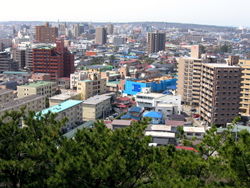 |
|||
|
|||
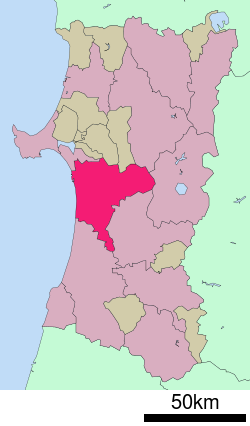 |
|||
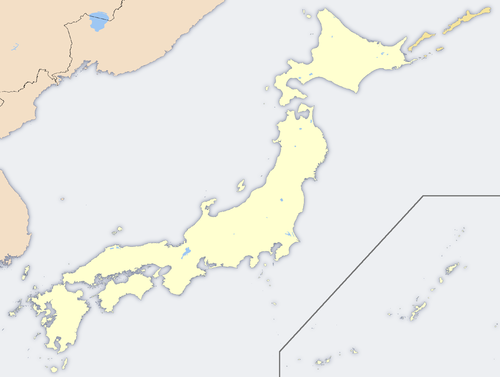 Akita
|
|||
| Coordinates: | |||
| Country | Japan | ||
| Region | Tōhoku | ||
| Prefecture | Akita prefecture | ||
| Government | |||
| - Mayor | Norihisa Satake | ||
| Area | |||
| - Total | 905.67 km2 (349.7 sq mi) | ||
| Population (January 1, 2010) | |||
| - Total | 325,905 | ||
| - Density | 359.8/km2 (931.9/sq mi) | ||
| Time zone | Japan Standard Time (UTC+9) | ||
| City Symbols | |||
| - Tree | Japanese zelkova | ||
| - Flower | Satsuki azalea | ||
| Phone number | 018-863-2222 | ||
| Address | Akita-shi, Sanno 1 chome, 1-1 010-8560 |
||
| Website | www.city.akita.akita.jp | ||
Akita is the capital city of Akita Prefecture in the Tohoku region of Japan.
As of June 1, 2007, with the merger of the former Kawabe District (including the former towns of Kawabe and Yūwa), the city has an estimated population of 336,250 and density of 364.6 inhabitants per square kilometre (944.3 /sq mi). The total area is 905.67 square kilometres (349.68 sq mi).
While the modern city was officially founded on April 1, 1889, Akita has been one of the most important cities in the Tohoku region since the medieval period. The Ashina and Satake daimyo clans established their capital in present-day Akita.
Contents |
History
Historically, Akita has seen changes throughout at least four historical Japanese periods; Edo, Meiji, Showa and Heisei. The beginnings of Akita were in the Edo period. A settlement, known as Kubota Castle Town, was formed which would later become the center of Akita. Construction is dated to 1604.
Meiji
Progress in the Meiji era included the renaming of the "Taihei" School (太平学校) to "Akita Normal" School (師範学校) on April 12 of 1878. In July, the school system was divided into 2 systems, the Kitaakita and Minamiakita districts. A year later, on April 1, 1889, Akita was officially established. In July the city hall of Akita is located inside the former Minamiakita District office. Transportation by horsecar began in July from Shindaikumachi to Tsuchizaki. This later became the Akita City Rail service. In May the first bank opened.
Showa
War devastated the city on August 14, 1945. 137 people were killed in an air raid of 134 B-29s, attacking the city from midnight to the early dawn of August 15. A Nippon Company oil refinery in the Tsuchizaki area was targeted. This was reportedly the farthest-range and also the last bombing mission in World War II, coming only hours before Japan announced its surrender.[1]
Heisei Era
On April 1, 1997 Akita was designated as a core city in Japan. In August 2001 The World Games were held in Akita, with the opening ceremony held in the Yabase Track and Field Stadium. In 2004, the city celebrated its 400th anniversary and its beginnings as Kubota Castle town.
Merger with Kawabe District
On January 11, 2005, the city added the towns of Kawabe and Yūwa to become the new city of Akita. The merger celebration was held at AL☆Ve.
The location of Akita City Hall did not change, and former Kawabe and Yūwa Town Halls are used as civic centers.
Go to the city of Akita's website for more info
Geography
Rivers and canals
- Omono River
- Akita-unga Canal (Formerly Omono-gawa River)
- Asahi-kawa River
- Iwami-gawa River
Neighboring cities
- Kita-Akita
- Katagami
- Yurihonjō
- Daisen
- Minami-Akita District: Gojōme, Ikawa
- Kita-Akita District: Kamikoani
- Senboku District: Nishiki
Climate
| Akita City | ||||||||||||||||||||||||||||||||||||||||||||||||||||||||||||
|---|---|---|---|---|---|---|---|---|---|---|---|---|---|---|---|---|---|---|---|---|---|---|---|---|---|---|---|---|---|---|---|---|---|---|---|---|---|---|---|---|---|---|---|---|---|---|---|---|---|---|---|---|---|---|---|---|---|---|---|---|
| Climate chart () | ||||||||||||||||||||||||||||||||||||||||||||||||||||||||||||
|
||||||||||||||||||||||||||||||||||||||||||||||||||||||||||||
|
||||||||||||||||||||||||||||||||||||||||||||||||||||||||||||
Akita has a humid subtropical climate (Köppen Cfa), with cool to cold, snowy winters, and hot and humid summers. Monthly means range from 0.0 °C (32.0 °F) in January to 24.8 °C (76.6 °F) in August. Due to its location near the Sea of Japan coast, it receives heavy snowfall, averaging 409 centimetres (161 in) per season, with accumulation occurring mostly from December to March. The annual precipitation, at 1,710 millimetres (67.3 in), peaks from July to mid-December, but is still significant in winter and spring.
| Climate data for Akita (1971-2000) | |||||||||||||
|---|---|---|---|---|---|---|---|---|---|---|---|---|---|
| Month | Jan | Feb | Mar | Apr | May | Jun | Jul | Aug | Sep | Oct | Nov | Dec | Year |
| Average high °C (°F) | 2.7 (36.9) |
3.1 (37.6) |
6.9 (44.4) |
13.6 (56.5) |
18.5 (65.3) |
22.8 (73) |
26.4 (79.5) |
28.6 (83.5) |
24.2 (75.6) |
18.2 (64.8) |
11.6 (52.9) |
5.8 (42.4) |
15.2 (59.4) |
| Average low °C (°F) | -2.7 (27.1) |
-2.7 (27.1) |
-0.5 (31.1) |
4.8 (40.6) |
9.9 (49.8) |
15.1 (59.2) |
19.4 (66.9) |
20.9 (69.6) |
16.0 (60.8) |
9.3 (48.7) |
3.7 (38.7) |
-0.2 (31.6) |
7.8 (46) |
| Precipitation mm (inches) | 114.4 (4.504) |
92.0 (3.622) |
93.0 (3.661) |
117.6 (4.63) |
122.8 (4.835) |
127.5 (5.02) |
178.1 (7.012) |
181.9 (7.161) |
177.9 (7.004) |
160.7 (6.327) |
183.5 (7.224) |
163.8 (6.449) |
1,713.2 (67.449) |
| Snowfall cm (inches) | 142 (55.9) |
120 (47.2) |
51 (20.1) |
2 (0.8) |
0 (0) |
0 (0) |
0 (0) |
0 (0) |
0 (0) |
0 (0) |
13 (5.1) |
79 (31.1) |
409 (161) |
| % Humidity | 73 | 72 | 68 | 68 | 72 | 76 | 79 | 77 | 76 | 73 | 72 | 73 | 73 |
| Avg. snowy days | 27.1 | 23.7 | 16.9 | 2.2 | 0 | 0 | 0 | 0 | 0 | 0.1 | 6.6 | 20.7 | 97.3 |
| Sunshine hours | 44.6 | 65.6 | 135.7 | 175.0 | 191.4 | 178.0 | 171.5 | 200.4 | 154.9 | 148.1 | 84.7 | 47.6 | 1,597.4 |
| Source: Japan Meteorological Agency | |||||||||||||
Economy

Akita is within proximity of the most important oil fields in Japan. Oil refining, woodworking, metalworking, and the production of silk textiles are the main industries. Akita is also home to two regional banks that serve Akita prefecture and the greater Tohoku region: Akita Bank and Hokuto Bank.
Education
Akita University
Akita Prefectural University, a public university, is located in the city.
Akita International University is a public university outside of town, taught solely in English.
North Asia University
Akita Nutrition Junior College
Misono Gakuen Junior College
Open University of Japan Akita learning center
Akita Rocket Launch Site
At 39.57148N and 140.05785 E between 1956 and 1990 81 sounding rockets of Japanese type Kappa were launched. Hereby heights up to 343 kilometres were reached. In 1990 several Russian sounding rockets of M-100 type were launched. Source: http://www.astronautix.com/sites/akita.htm
Marian apparitions
Our Lady of Akita is the title of Marian apparitions reported in 1973 by Sister Agnes Katsuko Sasagawa in the remote area of Yuzawadai, near the city of Akita. The apparitions were approved by the Holy See in 1988.[2] The 1988 approval was issued by Cardinal Joseph Ratzinger, who later became Pope Benedict XVI.
Sister / friendship cities
International sister / friendship cities
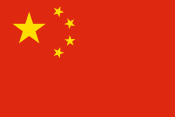 August 5, 1982: Lanzhou, People's Republic of China
August 5, 1982: Lanzhou, People's Republic of China April 8, 1984: Passau, Germany
April 8, 1984: Passau, Germany January 22, 1992: Kenai, Alaska, United States of America
January 22, 1992: Kenai, Alaska, United States of America 1993: St. Cloud, Minnesota, United States of America (with Yūwa, Akita, which merged into Akita, Akita)
1993: St. Cloud, Minnesota, United States of America (with Yūwa, Akita, which merged into Akita, Akita)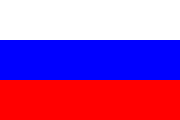 June 29, 1992: Vladivostok, Russia
June 29, 1992: Vladivostok, Russia
Domestic sister cities
- Hitachiōta, Ibaraki
- Daigo, Kuji District Ibaraki
Transportation
Rail
- East Japan Railway Company
- Akita Shinkansen: Akita
- Ōu Main Line: Ōbarino, Wada, Yotsugoya, (Akita Service Center), Akita, (Akita Freight Station), (Akita General Service Center: Adjacent to Tsuchizaki, branches to the right hand side before the station), Tsuchizaki, Kami-Iijima, Oiwake
- Oga Line: Oiwake
- Uetsu Main Line: Katsurane, Araya, Ugo-Ushijima, Akita
- Akita Rinkai Railway (Freight)
- Tsuchizaki—Port of Akita
- North Line: Port of Akita—North Port of Akita
- South Line: Port of Akita—Mukaihama
- Tsuchizaki—Port of Akita
- Akita District Forest Service
- Nibestu Shinrin Railway (Abolished)
Road
- Expressways
- Akita Expressway: Akita North Interchange, Akita Chūō Interchange, Akita South Interchange
- Japan Sea-Tōhoku Expressway: Akita Airport Interchange
- Kawabe Junction:Akita Expressway, Japan Sea-Tōhoku Expressway
- Akita Central Highway
- National Highways (Ordinary)
- Highway 7
- Highway 13
- Highway 341
Bus
- Akita Chūō Kōtsū
Air
- Akita Airport
Boat
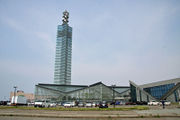
- Port of Akita (designated port)
- North Port of Akita (Akita Ferry Terminal)
- South Port of Akita
Famous personages
- Junko Kawada
- Junko Sakurada
- Nozomi Sasaki (fashion model)
- Taro Shoji
- Akane Suzuki
- Hiroya Matsumoto
- Hiroyuki Enoki
- Yukio Endo
- Shingo Kumabayashi
- Kohei Shimoda
- Taka Kato
Notes
- ↑ Reyher, Charles. Memoirs of a B-29 Pilot, page 146 (Lulu.com 2008): "This superfortress strike unwittingly collapsed a coup in progress at the Japanese Imperial Palace and saved Tokyo from a nuclear strike and ended World War II."
- ↑ EWTN on AKita approval
External links
- Official website in Japanese with links to versions in other languages
- English version of official website
|
|||||||||||||||||||||||||
|
|||||||||||||||||||
